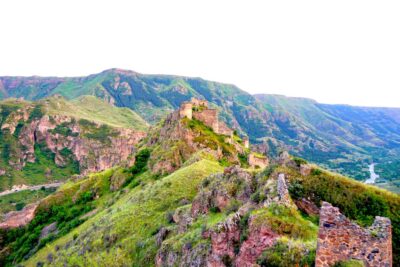Tmogvi Fortress – Tmogvi was one of the most important fortress cities of Javakheti. The Tmogvi fortress controlled the caravan road leading from Asia Minor to Georgia by valley of the river Mtkvari, closed the bridge connecting both river banks and protected the roads leading to villages.
The rise of Tmogvi begins at the turn of 8th and 9th centuries. From the end of the 12th century it was the residence of the Tmogveli family and the center of the frontier duchy. In the 16th century the Tmogvi fortress was occupied by Atabags of Samtskhe, the Jakelis at the end of the same century the fortress was captured by the Ottomans. In 1828 the Tmogvi fortress was returned to Georgia.
Several construction layers are distinguished on the fortress territory. The fortress was destroyed several times as a result of strong earthquakes but it was restored soon.
The fortress was connected with the river by a secret tunnel cut in the rock. The internal territory of the fortress was occupied by structures of various designations. Inscriptions found on the territory of the fortress city say that St. Marine’s domed church was built at the turn of the 13th – 14th centuries and the wall was built in 1350.
